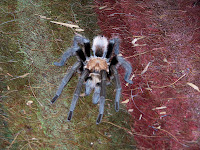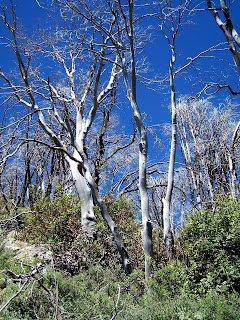 Part One[Written on June 29th]
Part One[Written on June 29th]There’s good news and bad news. The good news is that we still have half our summer vacation in the Colorado Rockies left. The bad news is that we only have half of our summer vacation in the Colorado Rockies left. Every day, every hour, is precious and we’re doing our utmost to make the most of our time here. Hiking for hours, planting trees and clearing snags, watching the birds, spending time on our swing at the highest point on the property watching a storm roll by

-- all are equally essential. We’ve had great evenings with local friends, two sets of overnight weekend guests (good friends we haven’t seen in a while and loved sharing our mountain getaway with), and we’re excited about the family visit this coming 4th of July weekend, complete with grandkids.

My experience is less than a tenth of my husband’s on this five acre plot of land. As a teenager he helped his dad build an A-frame cabin here,

and for decades it was a frequent destination for wilderness weekends or the odd week until it burned in the Hayman fire in 2002, within a couple months of our getting together. For a few years he couldn’t bear to visit, but when we did five years ago it was clear how much it meant to him (he’d always maintained it was the most important place on earth to him) and we set about figuring out a way to be able to visit for a few weeks each year from our home in Tucson, a 14 hour drive away. The answer, at least for now, has been a 33 foot Airstream Argosy travel trailer parked permanently on the bluff where the cabin stood. Strangely, the outhouse did not burn, so life in the Breadbox (“cabin” just doesn’t seem to work) is similar to life in the old A-frame -- electricity, but no running water -- though a bit more cramped and more significantly, without a fireplace. We’ve built a deck alongside almost twice the size of the trailer so we have a good deal of living space, provided the weather allows. For now it works for us, though with our eventual intent of spending four to five months a year here once Bob has retired in a few years, we are tossing around the idea of a small cabin -- with a wood-burning stove and indoor plumbing (as code requires). Time will tell.
But for now we are enjoying the greenest year in recent memory. Growth has been rampant, obvious to us not only due to our nine month absence, but also just in the week+ we’ve been here. The wildflowers are glorious. Low purple blue penstemons cloak whole hillsides, mountain laurel emit clouds of anise scented perfume, wild roses bloom in a perfusion of simple single pink blossoms. Indian paintbrushes and scarlet gilia provide sharp hot orange contrast to the soft blue and ivory of the Colorado columbines which look too perfect to be real. The round leafed alum still hangs from the shaded rock face cliff we pass as we enter the meadow following Little Turkey Creek, its creamy flower spires reaching for light.



Having to watch where you put your feet, on the trail or rambling cross-country through the forest, reaps the rewards of spotting the smaller, more insignificant though fascinating, wildflowers like shooting stars or meadowrue. We hiked the old jeep road to Turkey Rock and found it was carpeted with wildflowers, so thick that at times you couldn’t walk without treading on them with every footfall. Parts of the trail were smothered with wild strawberries, tiny pea-sized explosions of intensely sweet berry essence, more like jam than fresh fruit. Kneeling down, my husband showed me the greedy two handed picking technique, moving the fruit with twice the speed from the ground-hugging plants to the mouth. Ladybugs were everywhere, often flying in clouds disrupted from our passing.

Wildlife viewing has also been abundant. A huge elk with a sizable rack greeted us on the 16 mile dirt road between Highway 24 and our land. A few miles on, four elk does, two standing in a lake up to their chests, moved into the hills as we passed by. Deer are sporting their velvet antlers. And a bald eagle was perched on a tall snag (and me without a camera!), watching a small lake where we’d earlier seen a family of Canadian geese with two goslings, now nowhere in evidence. As we walked slowly towards the eagle he took off like an overloaded jetliner, so huge and incongruous with his surroundings, eventually landing on a tree on the far side of the lake, no doubt irritated about having had to squander energy to avoid a couple of star-struck birders.
My husband worries that the outhouse will become an obstacle to enjoying our time at the Breadbox, especially those middle of the night trips, but for those there is almost always a reward. On clear nights the milky way hangs like a cloud overhead, and some stars and most planets shine with the intensity of beacons. In the quiet darkness you might hear the call of a distant coyote, or a conversation between two great horned owls across the valley. After a few nights you quit worrying much about bear (though that is a possibility), using the flashlight only to find your way down the fifty foot path, often wearing nothing more than your sneakers (it’s amazing how you don’t notice the chill 40’s nighttime temp during the journey). It’s a sweet relief to return to your warm nest under the comforter, knowing you’re good until morning.
Part 2We’re back in Tucson now. The shock of leaving green and coming back to desert was tough. We’d aborted our day in Denver before flying back in favor of one last day alone in the mountains. While we missed seeing people we care about, it was a good call. We hiked to the bluff a half mile into Pike National Forest behind our place, a destination we’d never visited before. It looked so imposing from the front with its sheer rock face, but scouting around it the approach from behind was a shallow ramp of easy walking through dense wildflowers and between fascinating rock formations peppered with wild currants. The 360 degree view was spectacular – Turkey Rock, Pike’s Peak, Cedar Mountain with the Tarryall range behind. A good way to take it all in one last time this summer.

It was our fourth consecutive summer vacation at the trailer, and a benchmark trip for us. We realized that this was a place we’d like to spend a LOT of time as soon as we are free from work (probably within three years). A wonderful visit from Bob’s kids and grandkids and their dogs and their dog’s dog friend convinced us that we wanted more time like that, but that our beloved Breadbox probably wouldn’t fit the bill forever. We are dreaming of replacing the family cabin, lost seven years ago in the Hayman fire. Something small that sits on the footprint of the old place and reminiscent of it, though not a replica. One bedroom, one bath, a wood burning stove and a half loft with space for the many, many sleeping bags of family and friends. Oh, and running water and an indoor loo, though we’ll keep the outhouse just in case. It’s a dream now, but we hope it becomes a reality before too many more Breadbox summers pass.
We’re thinking that the best way to keep our love affair with the desert safe is to leave it in the cruelest months, from sometime in May to sometime in September. We’ll retreat to the Rockies where our days are filled with hiking in the cool thin air and our nights are spent under a comforter and a fire takes the chill away while we watch the first rays of sun hit Hackett Mountain every morning. Beats the heck out of holing up in the A/C for four months, restricted to being outside during the VERY early hours each day. Aside from a short attempt at getting snowed in each winter, we’ll spend the balance of the year in the perfection of the Tucson falls, winters, and springs.



 Paved, but narrow and twisting and unpainted, the black asphalt merged imperceptibly with the black lava soil, at places canopied by trees so dense you needed headlights. When we arrived at the entrance to the lava viewing area we were turned back by the park attendants -- the wind had shifted and the sulfurous steam clouds smothered the area, making it unsafe to be there. By bedtime there was quite a storm brewing, with rain lashing the windows and the ocean breaking hard on the reef.
Paved, but narrow and twisting and unpainted, the black asphalt merged imperceptibly with the black lava soil, at places canopied by trees so dense you needed headlights. When we arrived at the entrance to the lava viewing area we were turned back by the park attendants -- the wind had shifted and the sulfurous steam clouds smothered the area, making it unsafe to be there. By bedtime there was quite a storm brewing, with rain lashing the windows and the ocean breaking hard on the reef. 














































